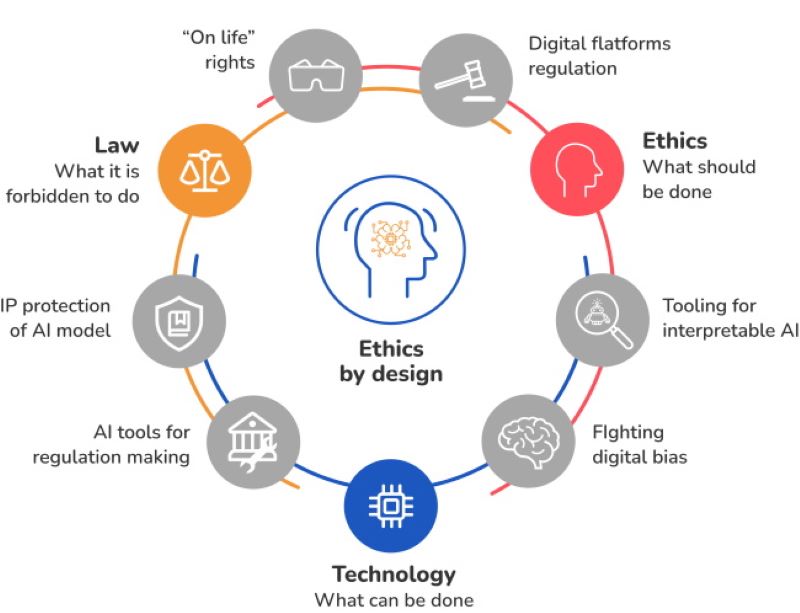Navigating the Digital Rapids: Can Regulation Match Technology’s Speed?
In this digital age, we race to keep up with gadgets and gizmos that transform our lives overnight. But here’s the burning question: How can regulation keep pace with the rapid evolution of digital technologies? It’s like trying to swim upstream in a river flowing faster by the second. I dive deep into the swirling waters of regulation, finding ways to stay afloat and forge ahead. We tackle the tight bends of digital technology regulation challenges, craft laws that move as quickly as tech does, protect our digital lives while cheering on innovation, and tune into a global beat where every nation steps together. Ready to ride these wild currents? Let’s go!
The Challenge of Digital Technology Regulation
Overcoming Obstacles in Digital Technology Regulation Challenges
Regulation often lags behind technology. Here’s why: Laws take time to make. They must be fair and clear. Tech moves fast, so this is tricky. Governments must review and adapt quickly. This means using new ways to keep laws fresh and in line. One way is a “regulatory sandbox.” This lets companies test new things safely. It’s like learning to swim with floaties before diving in.
New tech brings unknown risks. To manage them, we need tech-aware folks in law-making. They can spot problems early on. This helps everyone stay safe and sound. We don’t want bad surprises, do we?
Aligning Government Policies with Tech Growth
Tech grows like a speedy plant. Government policies must be good gardeners. They must provide the right tools for growth. It’s all about balance. Let’s keep innovation going strong. But let’s also watch out for thorny issues like privacy. We can’t ignore them. Laws must protect us, even online. Keeping track of all this is tough. We need smart thinkers as our guides.
Nations must talk to each other more. Tech knows no borders. So rules must work far and wide. This can stop gaps where sneaky things can slip through. We want a safe, open, digital world for all. This means sharing ideas and keeping each other sharp. Teamwork makes the dream work, right?
Working together, we can keep pace with tech. It’s like a race where rules keep changing. We don’t want anyone to fall behind. We can do this by sharing what we know. We just need to keep our eyes open and feet quick.
Adapting Legal Frameworks for Digital Dynamics
Crafting Adaptive Legislation for Tech Advances
Imagine a race between a sprinter and a speedboat. Tech growth is the speedboat, zooming ahead. Our laws, like the sprinter, struggle to keep up. To win, or even just keep up, we need to change the way we run. This means crafting adaptive laws for tech advances.
Adaptive laws must be flexible and update with tech changes. To make these, we ask: “What’s new?” and “What might happen next?” This way, we craft laws that grow with technology. By looking ahead, we keep consumer safety a top priority. But, how? We study trends, talk to tech experts, and watch how people use new tools.
Next, we write rules that are clear but not too narrow. Think of rules as fences in a big field. If we build them too tight, nobody can move. Too loose, and there’s chaos. We look for a sweet spot. It’s a tricky balance, but doable. We make sure these fences can move and grow.
Key to this? Listening to many voices. We bring in people who make tech, use it, and protect it. From coders to kids, we get everyone’s take. This way, we’re not just fair; we’re smart about how tech lives in our world.
Integrating Risk Assessment in Tech Regulations
But making flexible laws isn’t enough. We also need to think about what could go wrong. That’s where risk assessment in tech rules comes in. We look at new tech and ask: “What risks could arise here?” This can range from small glitches to big privacy breaches.
Then, we plan for these risks. We make rules that protect people if things go south. We don’t want a glitch in an app to lead to a big mess for a user. So we make standards to keep data safe and private. What does this look like? Think of seatbelts in cars. We want digital “seatbelts” in case of a tech “crash.”
Risk assessment is a team effort. We can’t just guess what could go wrong. We need tech people to show us the ropes. And we need regular folks to tell us what they’re worried about. Together, we can see risks more clearly and plan better shields against them.
In all this, we’re careful not to stifle new ideas. We want tech to grow, but people’s well-being comes first. It’s a dance between growth and protection, but it’s a dance we’re learning to master.
In short, keeping laws in step with tech means staying nimble and being ready to adapt. It means crafting rules that change with the times and are built on knowing the risks. And of course, it means keeping our eyes on the horizon for what comes next. It’s not easy, but it’s vital for safety, growth, and innovation in our fast-moving digital world.
Encouraging Innovation While Ensuring Protection
Balancing Privacy Laws with Technology Innovation
As a tech policy whiz, I face a tricky task every day. How do we let new tech bloom without harming our privacy? It’s like a high-stakes game of tug-of-war. On one side, we have tech wonders that can change our lives. On the other, we need rules so that our secrets stay safe online.
So, how do we keep this balance? First, it’s about making sure privacy laws keep up with how fast tech grows. Just think about smartphones. They didn’t exist not too long ago! Laws had to change fast to keep our texts and photos private. Those in the know call this ‘adaptive legislation’—law that shifts as fast as tech does.
It’s a tough dance to master. We don’t want to stomp on new ideas, but we can’t let our guard down. Tech companies need room to try new things. We get that. But we also need to make sure when things go south, our private info doesn’t go with it.
Utilizing Regulatory Sandboxes for Technological Experimentation
Ever heard of a ‘regulatory sandbox’? Picture a place where kids can play, build castles, and dig holes without getting hurt. That’s what we aim for with new tech. A sandbox is a safe space for companies to test fresh ideas. At the same time, we keep an eye on them. This way, they can’t harm us or our money.
It’s like letting someone test drive a car in an empty parking lot. They get the feel of the wheel without the risk of a crash. If the car has a flaw, better to know before it hits the road, right?
This is a big deal for stuff like AI and blockchain. These are game-changers that can get really complex. We need to try them out in the open, watch closely and learn. Then we adjust the rules as we go.
Sandbox magic isn’t just about keeping us safe. It’s also about being fair. We want many players in this game, not just the big fish. A good sandbox gives the little guys a shot at the big leagues. It levels the playing field so all can hit a home run.
The bottom line? Balancing privacy and innovation takes work. It’s about being quick, smart, and fair. We want to see tech soar, but without losing what’s private to us. With the right moves, we can ride the digital rapids and come out winners.
Global Coordination and Regulatory Agility
Promoting International Cooperation in Tech Regulation
Tech moves fast, and so must we. With each leap comes new fear: are we safe online? We need rules that grow with tech and protect us too. We ask: can nations work together to tackle tech’s swift changes?
Yes, they can. But it takes a lot. World leaders must sit and chat, and shake hands on rules that make sense across borders. That’s how we craft good government policies on tech growth, with every land adding their say.
We don’t want new tech to harm us. We want it to help us. For that, we need a plan that every country follows. Only then can the law really protect us as we click and swipe. It’s like a big team, where every player knows the goal: keep the net safe, make sure we play fair, and let the good stuff in tech shine.
Enhancing Regulatory Approach to Artificial Intelligence and Blockchain
Now, let’s talk big tech words: artificial intelligence and blockchain. These boys change things big time but also make us think: Can our rules keep up? Can they be clever and quick, like AI and blockchain?
You bet! Think like the tech. Make rules that can shift and slide, just like AI learns and grows. New tech means new tricks, and our laws have to learn these tricks too.
Keep an eye on AI; watch how it moves. Then, tweak the rules to stay in step. It’s a dance, and we gotta keep pace. For blockchain, it’s about trust. Let folks link up and share but keep crooks out. We’ve got to get smart on tech, and that means learning its steps.
Tech won’t slow down, so neither will we. We’ll make rules that are fair and fit snug with how fast tech runs. This way, tech can wow us, help us, and stay in line. It’s all about keeping our digital world safe, without snuffing out the spark that makes tech so thrilling.
By linking arms across the globe and staying limber, we make sure tech stays a force for good. We’ve got to be open, ready to shift, and always learning. Only then can we surf the digital waves, not sink beneath them.
Charity begins at home, but in the tech world, it must span borders. Moving together, we can write a story where tech keeps its charm, and we all stay safe. Let’s not drag our feet; it’s time to put on our dancing shoes and keep in step with tech’s rapid beat.
In this post, we’ve tackled the tough task of keeping digital tech in check. We started by spotting the hurdles in making rules that keep pace with tech. Then, we moved on to how laws must morph as tech evolves, weighing risks as we go. Next, we found a way to keep innovation alive without tossing out our need for privacy. We used sandboxes to test new tech safely. Lastly, we looked beyond our borders, talking about how countries must work together to keep up with AI and blockchain.
Now, think about this: the digital world won’t slow down. It’s on us to create smart, bendy laws that protect without stifling growth. We can do it with clear rules that give tech a playground while watching closely to keep everyone safe. It’s a tall order, but if we nail this balance, the tech of tomorrow can bloom responsibly and wow us all. Let’s keep pushing for the sweet spot where growth and safety meet.
Q&A :
How do regulations adapt to the fast-changing digital technology landscape?
With the exceptional speed at which digital technologies evolve, regulations adapt through a combination of forward-looking legislation, agility in policymaking, and collaborative efforts between governments and tech industries. This includes creating technology-neutral laws that address core principles rather than specific technologies, establishing regulatory sandboxes to test new innovations, and continuous stakeholder engagement to update and inform regulations as needed.
What challenges do policymakers face in regulating emerging digital technologies?
Policymakers grapple with several challenges when regulating emerging digital technologies, such as the rapid pace of innovation outstripping the slower legislative process, a lack of technical expertise within legislative bodies, ensuring privacy and security without stifling innovation, and the difficulty of predicting the societal impact of new technologies. Furthermore, global technology platforms raise questions regarding jurisdiction and the enforcement of local regulations on an international scale.
How can regulation promote responsible innovation in digital technologies?
Regulation can encourage responsible innovation by setting clear guidelines that ensure developers and companies prioritize ethical considerations, data protection, and user safety. It can foster an environment where responsible behavior is rewarded, perhaps through tax incentives or recognition programs. Additionally, involving various stakeholders in the regulatory process, including technologists, ethicists, and end-users, can lead to more nuanced and practical regulations that both protect the public and support technological advancement.
What role do international standards play in tech regulation and digital evolution?
International standards are crucial in providing a consistent framework for technology regulation, promoting interoperability and enabling global commerce. These standards can help streamline compliance for tech companies, reduce barriers to entry for new innovators, and ensure a certain level of quality and reliability across digital products and services. Standards bodies, such as the International Organization for Standardization (ISO), work to keep these standards in line with the evolving tech landscape.
Can self-regulation be effective in managing the progression of digital technologies?
Self-regulation can be a complementary approach to formal government regulations in managing the growth of digital technologies. This involves industries setting their own standards and best practices to address ethical, privacy, and security concerns. While self-regulation can be quicker to implement and more flexible, its effectiveness often depends on the level of enforcement and the commitment of companies to uphold their responsibilities. For this reason, many advocate for a hybrid model where self-regulation and formal legislation work in tandem.





